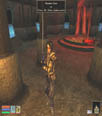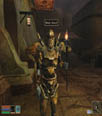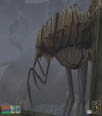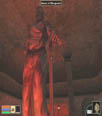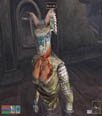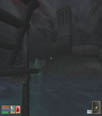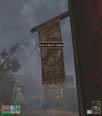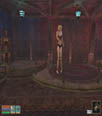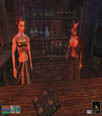INTRODUCTION
“Snatched from prison by the Emperor’s decree, you arrive at the port of Seyda Neen in the waning years of the Third Era with nothing but the name of a contact in Balmora… completely ignorant of the Prophecies of the Incarnate, your mission, and the role you are to play in Morrowind’s history.” – From the Morrowind cover.
Bethesda Softworks continues their Elder Scrolls series with the third installment, following their previous titles, Arena and Daggerfall. Morrowind, in the simplest terms, is a Role Playing Game (RPG). But oh, what an RPG it is!
The game is extremely non-linear and has so much detail packed in it that I was amazed that the main title was only contained on one CD. There is an additional CD for the add-on construction kit.
The story takes place on an island called Vvanrdenfell that is within the Morrowind province. It is east of the Empire explored in the in first two titles. The island itself is immense, but, as with most RPG’s, you must start off with the character creation…
MAKING THE PERFECT BEAST
Character creation is a bit more unique than other games because you start off without knowing anything about your character. The generation comes into play at the beginning of the storyline when someone asks you are. Then before any class types, race, or attributes are chosen, the player is taught the movements of the game by attempting to disembark a ship by simple tutorial.
Once off the ship, the player meets a non-player character (NPC) who just happens to be a census taker. At this point, you have three choices into creating your character: the census taker will ask you certain questions and recommend a class type, you choose one of the given character types, or attempt to create a mixed class.
There are ten different races, such as the Nord, Wood Elves, and Imperials, with eight attributes and various powers to choose from. Then there are twenty one different classes based upon twenty one different skills in combat, magic, and stealth. Skills such as Security, Long Blade, Short Blade, Light Armor, Medium Armor, and Alchemy define the character’s physical and magical prowess.
Each race and gender give bonuses to certain attributes and have their own specific powers. Attributes such as Strength, Intelligence, and Endurance can tell how strong the character is as well as how much weight they can carry or now much magical power they have.
For example, if the player chooses a Nord male, the character will be strong, use weapons well, and is resistant to frost. Nord females are just as strong as the males and are more resistant to magic than the males, but cant carry as much.
Skills are broken up into three groups: major, minor, and miscellaneous. All skills are placed into one of these three groups depending on the class, but there is no limit to what a character can learn as the game progresses. Major skills are easier to train than minor ones, but they all may be necessary later in the game.
In this example, the Nightblade class is a mix of stealth and magic skills. They prefer to cast spells to conceal them from their enemies and provide illusions. Training in the stealth and magic skills is easier, but the combat based skills are harder and take more time.
Then there are the twelve birth signs to choose from that can provide the character other bonuses and powers as well.
All this from just character generation! *whew!*
My main character ended up being a Wood Elf female in the Monk class. Wood elves make excellent archers, prefer light armor, and are stealthy by nature. The Monk class increased these stealth skills as well as preferred light armor or no armor at all. Also, the class made up for the lack combat skills by increasing the Hand-to-Hand Combat and Blunt Weapons skills. It also increased the Short Blade skill, but not enough to consider it a major skill. Although it was quite easy creating this character, there is always the notion of going back and creating another character in order to try something new and different.
The citizens of Morrowind will act differently based on the race and gender. Many of the townsfolk of Balmora are more hospitable to those of the Dark Elf race while the people of Seyda Neen tend to frown upon them.
I even found that a few NPCs would taunt my character with an unkindly name every now and then!
Solutions to quests may vary dependent on the class, race, and gender chosen. Stealthy characters have more of a chance of stealing items from NPCs without their knowledge but more combat trained characters may have to kill the NPC to get the item they are after, but then there is the risk of retribution from others.
Then again, a character of the opposite sex may be able to persuade the NPC into giving up the item all together.
Speaking of quests…
GET THIS, DO THAT
Questing is the main focus of any RPG. Morrowind is no exception. There is the primary quest that is to be fulfilled with side quests that can be done, but eventually the player has to go back to the primary quest. Linear games like that tend to be really boring.
This is one of the best things about Morrowind in that other than the tutorial, the game is completely non-linear.
If you don’t want to do the main quest, then don’t. Its not really a requirement to have fun. There are plenty of side quests and other work that can be done. The game wont force you into going back to the main quest. Even if you are tasked to do a smaller quest, its not a requirement that it has to be done, but it may impact other quests within the game.
Once your character is created, the primary quest begins with the census taker giving you the name of person in the nearby town of Balmora and a package to deliver. After that, you are promptly kicked out the door and you are on your own.
Once out in the town Seyda Neen, you may choose to go through the town and talk with everyone, find your way to Balmora, or explore this huge world. The one big plus that is in Morrowind that wasn’t in previous Elder Scroll titles: transportation! You have the choice of riding a large insect to the next town like a bus or you can walk to the next town. That may take quite of bit of time considering how big the island is.
There is even teleportation and boat rides for the island…
An advantage of going on foot is that it allows a player to earn experience through combat or money by picking up plants or flowers that can be sold later on as ingredients. It can also improve the Athletic skills from the constant running…
While in towns, a player go thru baskets and crates to find items to sell for money. You can go thru people’s homes if the door isn’t locked and rob them blind. Even if it is locked, you can pick the lock or use magic to open it.
Of course, if you do this in front of the home owner, they will call the guards and you can be tossed in jail and/or be forced to pay a fine. Continue getting caught by the guards, then townsfolk will begin disliking you. They may even put a bounty on your head.
When talking to people, a meter notes their disposition towards you; basically, how much they like, dislike, or perhaps fear you. The more their disposition is to you, the more useful information they will give you. They may even request a quest for money or equipment. A player can even do the quest, increase their disposition for you, then while they aren’t looking, rob them blind. (This is actually a requirement for a smaller quest!)
Certain classes will group together in guilds. They can provide quests to provide funds for better equipment and experience. Quests tend to revolve around the guild’s politics so NPCs may act differently depending on whether or not the task was completed.
Guilds also provide training for skills at a cheaper rate than a non-guild trainer. Even if you cant afford training, you can train yourself thru quests or thru different activities. Fighting with a Long Sword will improve the Long Blade skill while swimming thru the water will improve the Athletics skill. Reading certain books can also improve skills.
A player can even begin to repair equipment as well as create spells and potions. Those potions could even be sold off for money. As your character grows with experience, then the main attributes can be increased to improve health, magical power, and endurance. There is no limit to what can be done.
This is compounded with the additional construction kit. Players can create quests and send them out to others to play. It also allows for the creation of weapons, armor, equipment, races, and land.
There are simply endless possibilities.
GRAPHICS
A lot of work went into the graphics of this game and it shows.
Even in my 800×600 mode, Morrowind’s countryside is spacious with the distinct colors and shapes of landmarks. This is very important because many quests involve a player being able to find those landmarks in order to find caves or bridges.
Cities can range from a clean suburb to a dirty metropolis. Creatures at a distance can be seen getting larger as they close in on you. Every character is well drawn and their racial tendencies are brought out. Skin tones, hair and body types are distinct as well.
When people talk, their mouths even move in sync with the text. This may not sound like a major issue, but it can become a distraction (Can we say Bridge Commander?!). Fortunately, Morrowind doesn’t suffer from this.
Pertinent information is displayed in menus; your characters stats, a map of the area around you, and your inventory. One trivial complaint I have is with the inventory list. Your inventory can be filtered to show weapons, clothes, magical items, and miscellaneous items. When the menu is shrunk, the items will wrap to the size of the screen, but the filter buttons don’t. This is more of just a personal preference since the menus are like any window and can overlay each other.
SOUND
Morrowind’s sound adds more flavor to the game environment.
The 3d effects are abundant. Your footsteps can be heard when splashing across water. Rain and thunder are explode during a storm. Creatures can be heard around corners and from distances. NPCs will talk to you as you walk by or even taunt you during combat.
Even if you cant understand the NPC because of their strong accent (or in my case, from trying to fold laundry while playing), subtitles can be turned on to read what is being said.
Music is in MP3 format and very crisp. Even better, it can be lowered to improve the frame rate of the game or if you are simply don’t want to hear it.
SUMMARY
The Elder Scroll series became famous in the 1990’s with Arena and Daggerfall. Morrowind is a title worthy to continue the series.
Even though I rated the game as a 9, I will admit I was tempted to give it an 8.5 because of some of the technical aspects.
Depending on CPU speed, RAM, and video card, a player may suffer from video and processing lag. Options and video adjustments will be necessary to minimize or prevent this. I decided to keep the score because I could still run the game straight out of the box with some minor lagging when the screen was busy.
After a couple of minutes tweaking, the only lag I have now is when my character runs into different map co-ordinates and my CPU isn’t fast enough to keep up.
Despite the technical issues, Morrowind still provides a fun atmosphere with its large game world, variable character classes, non-linear format, great graphics, and strong sound.
In Morrowind, anything can happen… And with the construction kit, it can only get bigger.
 Bjorn3D.com Bjorn3d.com – Satisfying Your Daily Tech Cravings Since 1996
Bjorn3D.com Bjorn3d.com – Satisfying Your Daily Tech Cravings Since 1996
